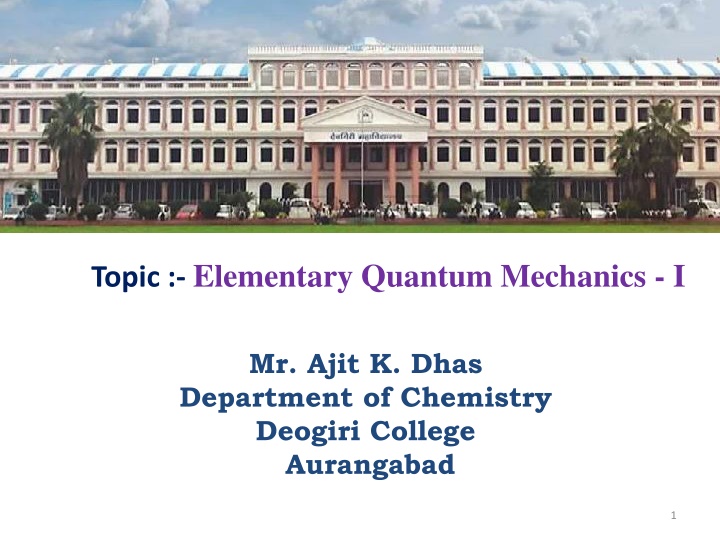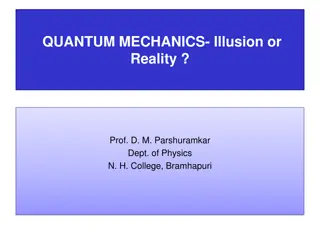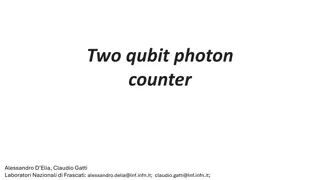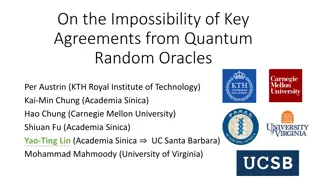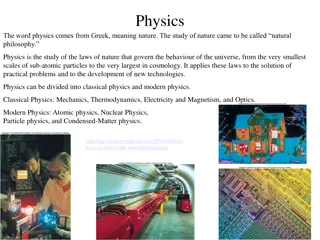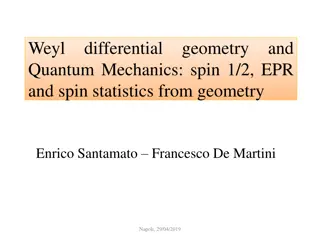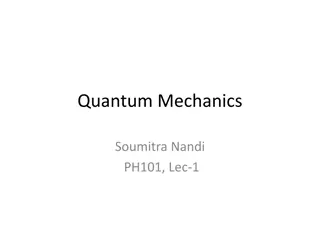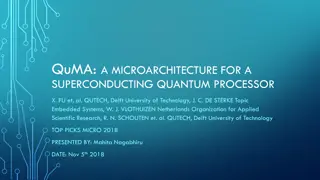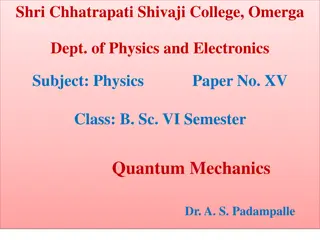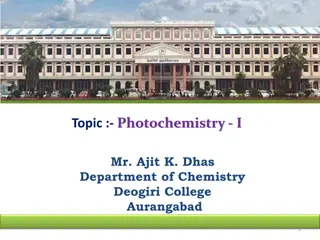Elementary Quantum Mechanics Overview at Deogiri College Aurangabad
Delve into the world of elementary quantum mechanics with Mr. Ajit K. Dhas from the Chemistry Department at Deogiri College in Aurangabad. Explore the fundamental principles, theories, and applications of quantum mechanics in a simplified manner. Gain insights into the behavior of matter and energy at the atomic and subatomic levels, laying the groundwork for deeper understanding and advancing knowledge in the field of chemistry.
Download Presentation

Please find below an Image/Link to download the presentation.
The content on the website is provided AS IS for your information and personal use only. It may not be sold, licensed, or shared on other websites without obtaining consent from the author.If you encounter any issues during the download, it is possible that the publisher has removed the file from their server.
You are allowed to download the files provided on this website for personal or commercial use, subject to the condition that they are used lawfully. All files are the property of their respective owners.
The content on the website is provided AS IS for your information and personal use only. It may not be sold, licensed, or shared on other websites without obtaining consent from the author.
E N D
Presentation Transcript
Topic :- Elementary Quantum Mechanics - I Mr. Ajit K. Dhas Department of Chemistry Deogiri College Aurangabad 1
Elementary Quantum Mechanics Content: Black body radiation, Photoelectric effect.
Introduction In the late 17th century, Isaac Newton discovered Classical Mechanics, the science of motion of macroscopic (large) objects. This Classical Mechanics successfully explained the motion of particle from everyday objects to planets. However, towards the end of 19th century, classical mechanics was unable to correctly describe the behavior of microscopic particles such as electrons and nuclei of atoms and molecules (subatomic particles). This quest to understand the microscopic behavior gave birth to a new theory called Quantum Mechanics. Quantum mechanics came out as a greatest discovery of the 20th century.
What is Quantum Mechanics? The term QuantumMechanics is made up of two words QUANTUM + MECHANICS. The term Mechanics refers to the science of motion of an object. The other word is Quantum which is Latin word for amount and in modern conventions is used to represent smallest possible discrete unit of any physical property. Quantum Mechanics replaces Classical Mechanics at the atomic or subatomic levels (electrons and nuclei in atoms and molecules). It gives the laws of motion of microscopic objects (the way classical mechanics gives for macroscopic objects). Quantum Mechanics is therefore the theoretical science of microscopic matter.
Maxwells electromagnetic wave theory Electromagnetic radiation propagate in the form of wave. It consist of electric and magnetic field perpendicular to each other. They can travel through empty space. Waves other than electromagnetic waves have to travel through some substance. For example, sound waves will need either a solid, liquid or gas to pass through. The speed of light which is 3 x 108m/s is always constant. Wavelength is commonly characterized by the symbol . It is the measure between the distance of either troughs or crests.
Plancks Quantum Theory According to Planck s quantum theory, Different atoms and molecules can emit or absorb energy in discrete quantities only. The smallest amount of energy that can be emitted or absorbed in the form of electromagnetic radiation is known as quanta. The energy of the radiation absorbed or emitted is directly proportional to the frequency of the radiation. Meanwhile, the energy of radiation is expressed in terms of frequency as, E = h Where, E = Energy of the radiation h = Planck s constant (6.626 10 34J.s) = Frequency of radiation
Black body radiations Black body: The object which absorbs and emits the radiation of energy completely is called a black body. Practically it is not possible to construct a perfect black body. But a hollow metallic sphere coated inside with platinum black with a small aperture in its wall can act as a near black body. When the black body is heated to high temperatures, it emits radiations of different wavelengths.
Black body radiations The following curves are obtained when the intensity of radiations are plotted against the wavelengths, at different temperatures.
Following are the conclusions that can be drawn from above graphs. 1) At a given temperature, the intensity of radiation increases with wavelength and reaches a maximum value and then starts decreasing. 2) With increase in temperature, the wavelength of maximum intensity ( max) shifts towards lower wavelengths. According to classical physics, energy should be emitted continuously and the intensity should increase with increase in temperature. The curves should be as shown by dotted line.
In order to explain above experimental observations Max Planck proposed the following theory. Quantum theory: 1) Energy is emitted due to vibrations of charged particles in the black body. 2) The radiation of energy is emitted or absorbed discontinuously in the form of small discrete energy packets called quanta. 3) Each quantum is associated with definite amount of energy which is given by the equation E=h . Where, h = planck's constant = 6.625 x 10-34 J sec = 6.625 x10-27 erg sec = frequency of radiation 4) The total energy of radiation is quantized i.e., the total energy is an integral multiple of h . It can only have the values of 1 h or 2 h or 3 h . It cannot be the fractional multiple of h . 5) Energy is emitted and absorbed in the form of quanta but propagated in the form of waves.
Photoelectric effect: Photons According to quantum theory, light is not continuous but it is discrete and consists of small bundles or packets of energy called photons. Properties of photon 1. A photon always travels with the velocity of light. 2. Photons are electrically neutral. They cannot be deflected by electric or magnetic fields. They do not ionize. 3. Rest mass of photon is zero. 4. Energy: E = h = hc/ . 5. Mass: E = mc2, m = E/c2 = hc/c2 , Mass= h/c 6. Momentum: p = mc = h
Photoelectric effect: Photoelectric Effect The emission of electron by metal surface when illuminated by light or any other radiation of suitable wavelength or frequency is called photoelectric effect. Einstein s photoelectric equation According to Einstein s explanation, in photoelectric effect one photon is completely absorbed by one electron, which thereby gains the quantum of energy and may be emitted from metal. The energy of photon is used in two parts: A part of its energy is used to free the electron from the atom and away from the metal surface. This energy is known as photoelectric work function. Other part of energy is used to gain the kinetic energy to the electron.
Photoelectric effect: h = W + K.E Where, W = energy required to overcome the attractions K.E = kinetic energy of the electron This equation is known as Einstein s photoelectric equation. When the photon s energy is of such a value that it can only liberate the electron from metal, then the kinetic energy of the electron is zero. where is called the threshold frequency. Threshold frequency is defined as the minimum frequency which can cause photoelectric emission. Since the frequency corresponding to the minimum energy required to overcome the attraction is called threshold frequency, o, the above equation can be written as: h = h o + K.E or K.E = h o- h = h ( o- )
